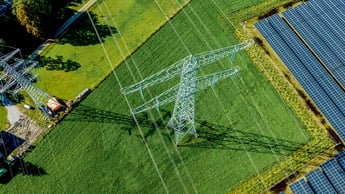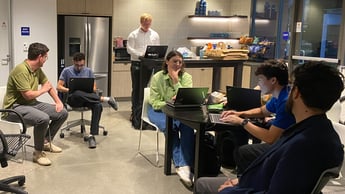Shaping the infrastructure of the future
What will the IT infrastructure of the future look like? How will a company’s infrastructure need to develop to keep up with the increasing speed of change? Where can it help to deliver sustainable value to the business? Sebastiaan Laurijsse, senior director at NXP Semiconductors, shares his vision on the infrastructure of the future.
“When talking to others about the infrastructure of the future, I often hear topics like automation, cloud-based infrastructure, and the essential role infrastructure will have. ‘IT as utility’ is a statement that we made ten years ago, and I stand by it to this day. But what does that actually mean for the business, and for the end user? How do they benefit from automation, ‘always-on’ IT, and other developments? To answer that, I want to look at value streams, setting strategic goals, and ways to achieve those goals.
First, we need to look at the place IT-infrastructure has in a business. The Scale Agile Framework identifies two types of value streams in any organization. The first type is Operational Value Streams. These streams represent what the company is about, and how it generates revenue. This could range from a simple online shop, to a high-tech manufacturing company making billions of products every year, with complicated supply chains and demand prediction processes. Operational value streams are about delivering customer value and generating cash.
The second type is Development Value Streams. These streams support and develop solutions that are used by the Operational Value Streams. Infrastructure falls in this second category. To be successful, infrastructure needs to help the business to generate the most revenue, at the lowest cost, with the lowest risk, and to use available resources effectively.
Removing waste
One way to achieve this is by reducing the lead time of processes. Lead time is the time it takes from when a task is created, to the moment work is completed. For example, lead time is the time between placing your order in an online store and the product arriving on your doorstep. If this process takes too long or is too complex, there is risk of a breakaway moment, leaving the customer dissatisfied. The actual cost for a company, however, is not always in the lead time, but in the cycle time. This is the time from the moment work starts to the moment it is finished. I believe it is critical, when looking at your infrastructure, to ask: how can you reduce lead time and cycle time, improve quality, and simultaneously operate at a specific cost level? A strong method to do this is to eliminate waste in the value chain.
Lean categorizes waste in eight types, which can be easily remembered with the acronym ‘Tim Woods’: transportation, inventory, motion, waiting, overprocessing, overproduction, defects, and skills. The infrastructure of the future needs to understand how to operate within the context of these waste types. How can cloud, for example, contribute to waste elimination by reducing waiting time or defects? If we really want to see IT as a utility, that is the level we need to operate at.
So how are we going to do this? How will we achieve those results of reducing lead time, eliminating waste, and improving overall quality, while operating at benchmark costs? There are many technological solutions, such as automated deployment, integrated testing, and the use of CI/CD pipelines that contribute to this goal. At a user level, providing self-service means putting autonomy, power, and capabilities in the hand of the end user. The use of AI and data will also play a big part in this. But how do you decide which solutions to use, and where to start?
Zooming out
For NXP’s IT services, we defined a set of strategic themes that influence every decision we make regarding infrastructure. Our strategy is about improving the agility of IT services, increasing reliability and resilience of services, reducing risk, increasing cost control, a strong customer focus, and the development of people and culture.
Looking at the different types of waste, you can map each of them to one or more of these elements. Improving agility, for example, benefits from using automation to reduce waiting times. Putting the customer first can be done by empowering them with self-service capabilities. And developing people ensures you use the fullest of their capabilities. Because not having the desired skills, competences, and behavior will impact your company performance. So, if you want to make sure that your company is making an impact, grows sustainable revenue, and has a portfolio for the future, you need to develop your people. This led to the vision for our IT portfolio: to secure NXP growth by delivering agile, reliable, and secure digital products at benchmark costs.
Key elements in implementing this vision are data, tools, and people.
"Data will be applied to automate decision making in infrastructure and security processes."
Data-driven automation
As mentioned earlier, data will play a big part in the infrastructure of the future. Automating existing processes is usually straight forward, as is orchestrating processes where governance has been established. But further automation with the use of data will be a cornerstone for the infrastructure of the future. Data will be applied to automate decision making in infrastructure and security processes. This means moving away from the break-fix mentality, where we wait for an outage to happen and determine the problem afterwards. Data will be analyzed to identify issues preemptively, and propose a course of action to prevent problems from having a real impact.
This means data needs to be orchestrated and facilitated, using principles of DevOps. One example of where we use data to automate decision making, is the use of Amazon Spot prices to determine if jobs can run on a compute cluster in the cloud. Changes in pricing are monitored and, as they rise or fall to a specific level, the system automatically allows or disallows certain jobs. We built the decision automation directly into those processes. As a result, we always run at an optimal cost level, with reliable and secure sources.
Infrastructure becomes software
So what tools do we use? The answer is: a lot! This is key, as infrastructure is becoming software. We support and facilitate a broad set of tools, allowing people to work in the environment that is right for them but simultaneously making sure that they comply to our requirements. Of course, physical stacks and cabling will still be there, but for development and operations purposes the focus will be on software for infrastructure.
People are key
The final and most important component of the infrastructure of the future: people. If you want to make any impactful change in your organization, you need to pay attention to the people. I can share that, no matter how many wonderful tools we have, we are not yet yielding all their benefits. And this is not just a matter of teaching people the skills to use these tools – it is about the mindset. The mindset of working digital, but also the mindset of, for example, people that worry about the future of their role. If you do not manage this transformation properly, the organization will struggle with the implementation of new technology. At NXP, we developed a persona to help us with this. The use of a persona provided us a clear vision of the employee of the future and helped to share that vision internally.
In the end, digital transformation is a process of continuous change. Those who are able to change, will be able to survive. A company with the ability to produce faster, cheaper, and better than its competitor will become successful. This requires technology, processes, and people. The infrastructure of the future needs to add sustainable value to a company’s operational value streams, without taking a single second of their attention away. Even better, it can start to predict their future needs. The infrastructure of the future is about making the business operate at light speed.”






